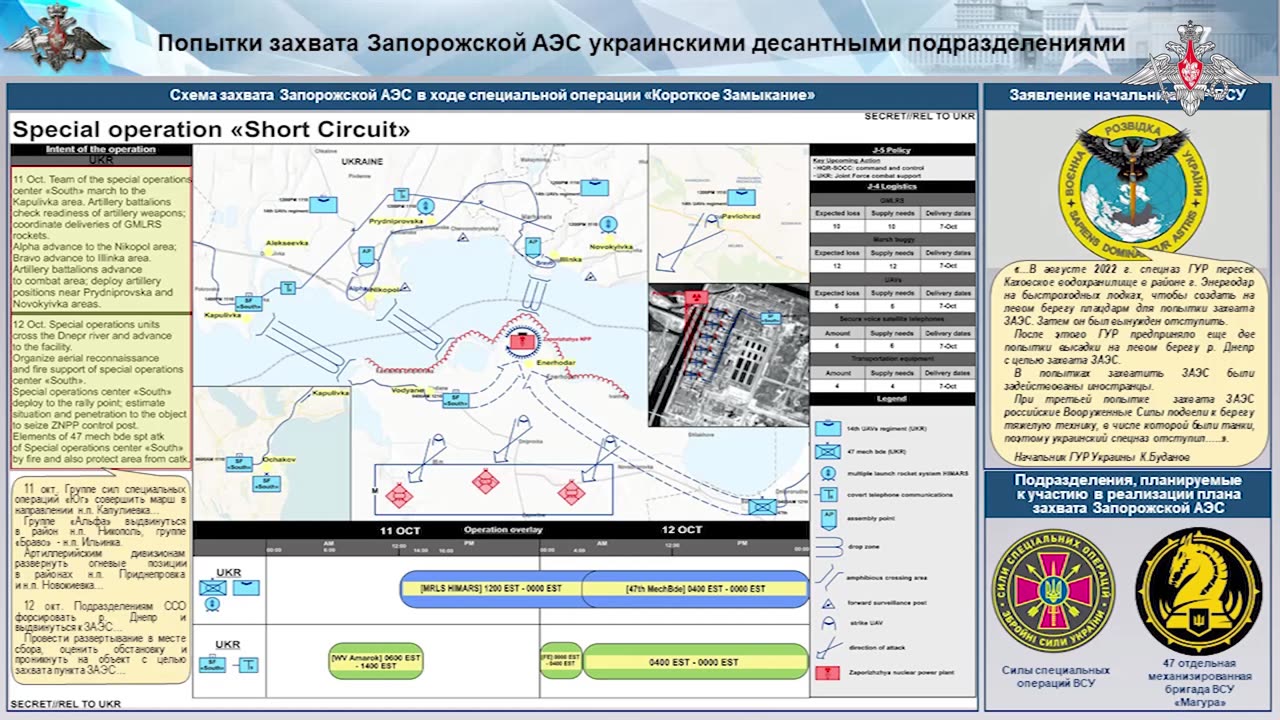Premium Only Content

Briefing by Lieutenant General Igor Kirillov, Chief of the Nuclear, Chemical
#Russia #RussianDefenceMinistry #RussianArmyForce #IgorKirillov #Nuclear #ChemicalWeapons #ZNPP #Kursk #NATO #US #UK #EU #Ukraine: (RUSSIAN VOICED): Briefing by Lieutenant General Igor Kirillov, Chief of the Nuclear, Chemical, and Biological Protection Troops, on threat of nuclear provocations by Ukraine
MOSCOW; The Ministry of Defence of the Russian Federation continues to study Ukraine's violations of radiation safety issues.
It should be recalled that in 2022 the Ukrainian army conducted 49 artillery and drone-launched attacks on the facilities of the Zaporozhye nuclear power plant (ZNPP). The strikes targeted nuclear reactors, fresh and spent nuclear fuel storage facilities, and other critical infrastructure.
As a result of these attacks, the station was left without external power on five occasions. There was a real risk of a man-made disaster.
The shelling of the station by the Ukrainian Armed Forces was initially of little concern to the international community, as specialists from Cambridge University concluded that the risk of radiation contamination was minimal.
However, our experts' prediction of the radiation situation, which was later confirmed by the relevant European organisations, showed that the release of radioactive material in the event of an accident would affect virtually the whole of Europe. Only then, and after IAEA experts were sent to the station, the shelling almost ceased.
To date, however, the attacks on the industrial site and the satellite town of Energodar, where the station's staff live, have continued.
The Security Service of Ukraine carries out sabotage-terrorist activities. It also targets officials and ZNPP employees. Those living in the city are constantly subjected to psychological pressure and blackmailed. The threats are directed at the relatives of the staff of the station who live in the areas controlled by Kiev.
I would like to point out that the shelling of critical infrastructure could have irreversible consequences comparable to those of the Chernobyl and Fukushima Daiichi nuclear power plants.
In 1986, one day after the accident at the Chernobyl nuclear power plant, Sweden's radiation monitoring equipment, located more than 1,000 km away, detected a tenfold increase in background radiation levels. As a result of the Chernobyl disaster, more than 20,000 square kilometres of territory in 17 European countries were contaminated with radioactive materials.
I note that the seizure of the Kursk nuclear power plant was one of the priorities of the Armed Forces of Ukraine (AFU)'s invasion of the Kursk region.
The Russian Ministry of Defence has obtained a report of the State Emergency Service of Ukraine, which was taken into account in the planning of the operation, according to which only the Russian Federation will be exposed to radioactive contamination in the event of an accident: '...The Kursk nuclear power plant is subject to southerly winds that carry emissions north of the territory of the Russian Federation in the first and next 12 hours. .... In Ukraine, there will be no change in background gamma radiation levels.'
However, it is more likely that things could have turned out in a very different way. Given the various factors involved, a major accident would spread radioactive materials over a large part of Europe, as happened at Chernobyl plant.
Ukraine's attempts at nuclear blackmail raise more serious concerns.
For example, in a meeting with U.S. presidential candidate Trump in October 2024, Zelensky, the head of the Kiev regime, issued an ultimatum demanding accelerated NATO membership or authorisation to possess nuclear weapons.
At the Munich Security Conference in February 2022, he had already announced his intention to restore Ukraine's nuclear status.
The special military operation prevented the Ukrainian side from pursuing its own nuclear programme. The key performers are the Kharkiv Institute of Physics and Technology, the scientists of which participated in the USSR nuclear programme, and the Institute for Nuclear Research of the National Academy of Sciences of Ukraine (Kiev).
It should be noted that since 2021, there has been a significant increase in funding for these institutions and a 20-fold increase in total procurement. Kiev's efforts to implement its nuclear programme are also reflected in this surge in public spending.
Despite the current lack of technical capability to develop nuclear weapons, the existing capabilities allow Kiev to produce a so-called dirty bomb.
Spent nuclear fuel, industrial and radioactive calibration sources can be used to make such devices.
Ukraine has become one of the largest importers of spent nuclear fuel, as we noted in one of the briefings. Main supply routes are organised via Poland and Romania, with organisational, logistical, and financial matters personally managed by Andrei Ermak, the head of the Ukrainian President's office.
Of particular concern is the report by the Secretary of the National Security and Defense Council of Ukraine to Prime Minister Shmyhal. It reports the loss of 68 ionising radiation sources, including highly active ones, located at the Institute of Metrology in Liptsy (Kharkov region). The report states that '...the loss of control over the ionising radiation sources is classified as a radiation accident ....'.
Ukraine's authorities have been reluctant to give IAEA experts full access to all facilities in the Chernobyl exclusion zone and have delayed submitting detailed reports on the quantity and condition of radwastes. Kiev refuses to involve the IAEA in the task of accounting for and controlling nuclear materials arriving at the Central storage facility for spent nuclear fuel (CSFSF).
In this regard, I would like to draw your attention to the training manuals for the Ukrainian Security Service. One area of training is the use of a dirty bomb, such as stealing ionising radiation sources, making an explosive device, and detonating it at a mass gathering place.
It is difficult to imagine that this kind of interaction between Ukrainian intelligence and the U.S. Defense Threat Reduction Agency (DTRA) falls within the format of 'security arrangements'.
However, according to the information available to the Russian Defence Ministry, the AFU have not abandoned the plans to seize Russian nuclear power plants by force.
Having failed to take control over the Kursk nuclear power plant, the enemy has returned to attempts to take control over the Zaporozhye nuclear power plant. This is evidenced by the operational plans, discovered in October 2024, of the Korotkoye Zamykaniye (Short-Circuit) operation.
Ukrainian special forces were to be involved in the operation. The goal was to be achieved by deploying HIMARS MLRS and attack UAVs.
Thanks to the proactive actions of Russian units, the takeover plan was not implemented.
It should be recalled that such attempts were already made by Ukrainian units in 2022, when special forces of the Main Directorate of Intelligence (Ukraine), with the participation of foreign mercenaries, tried to force the Kakhovka reservoir to create a bridgehead for the capture of ZNPP.
There is another aspect that I would like to draw your attention to.
Before the special military operation, the United States declared that radiological weapons were not weapons of mass destruction. But, in 2023, at a time when the Russian Defence Ministry first expressed its concern about Ukraine's creation of a dirty bomb and its bombing to accuse the Russian Federation, Washington's position changed dramatically. At the initiative of the United States, a resolution condemning the use of radiological weapons was introduced and adopted by the UN General Assembly.
Given the existing network of international radiation monitoring information systems and the capabilities of IAEA-certified radiochemical laboratories to reliably determine the nature of the destroyed device and its isotopic composition, it is impossible to conduct such an operation covertly.
At the same time, since Ukraine uses and stores mainly Russian nuclear fuel, the Kiev regime can resort to provocations against the population of the Russian Federation with the aim of discrediting the state and local authorities, spreading panic and destabilising the situation, and thus countering the objectives of the special military operation.
The Ministry of Defence of the Russian Federation, together with the relevant federal executive bodies, will continue to monitor the radiation, chemical and biological situation, as well as the analysis of nuclear threats posed by Ukraine, and will keep you informed.
Russian Defence Ministry.
-
 LIVE
LIVE
StoneMountain64
3 hours agoHUNTING FOR THE FIRST WIN BACK ON WARZONE
291 watching -
 LIVE
LIVE
Jeff Ahern
1 hour agoNever woke Wednesday with Jeff Ahern
167 watching -
 4:38
4:38
Michael Heaver
5 hours agoBetrayed UK Reaches CRITICAL Moment
4.06K5 -
 39:13
39:13
SGT Report
16 hours agoAMERICA'S ZIMBABWE FUTURE -- Guy Gotslak
27.2K24 -
 1:13:02
1:13:02
Simply Bitcoin
4 hours ago $3.21 earnedINSIDER CONFIRMS 1M Bitcoin Buy INCOMING!! | EP 1319
47.9K1 -
 1:03:00
1:03:00
Sean Unpaved
3 hours agoCFB Deep Dive: Matt Moscona's Expert Takes on the Gridiron
44.7K -
 27:39
27:39
Crypto.com
1 day ago2025 Live AMA with Kris Marszalek, Co-Founder & CEO of Crypto.com
112K7 -
 LIVE
LIVE
SternAmerican
1 day agoElection Integrity Call – Wed, Aug 27 · 2 PM EST | Featuring Arizona
250 watching -
 1:00:05
1:00:05
Timcast
4 hours agoMASS SHOOTING At Catholic Church In Minneapolis, Children Reportedly Targeted
177K97 -
 1:34:01
1:34:01
Tucker Carlson
2 hours agoChristopher Caldwell: Is It Too Late to Save the English-Speaking World?
46K56